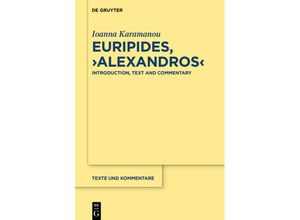This is the first full-scale commentary on Euripides' Alexandros which is one of the best
preserved fragmentary tragedies. It yields insight into aspects of Euripidean style ideology
and dramatic technique (e.g. rhetoric stagecraft and imagery) and addresses textual and
philological matters on the basis of a re-inspection of the papyrus fragments. This book
offers a reconstruction of the play and an investigation of issues of characterization staging
textual transmission and reception not least because Alexandros has enjoyed a fascinating
Nachleben in literary dramaturgical and performative terms. It also contributes to the
readers' understanding of the trends of later Euripidean drama especially the dramatist's
innovation and experimentation with plot-patterns and staging conventions. Furthermore the
analysis of Alexandros could stimulate a more comprehensive reading of the extant Trojan Women
coming from the same production which bears the features of a 'connected trilogy'. Thus the
information retrieved through the interrogation of the rich fragmentary material serves to
supplement and contextualize the extant tragic corpus showcasing the vitality and multiformity
of Euripidean drama as a whole.



